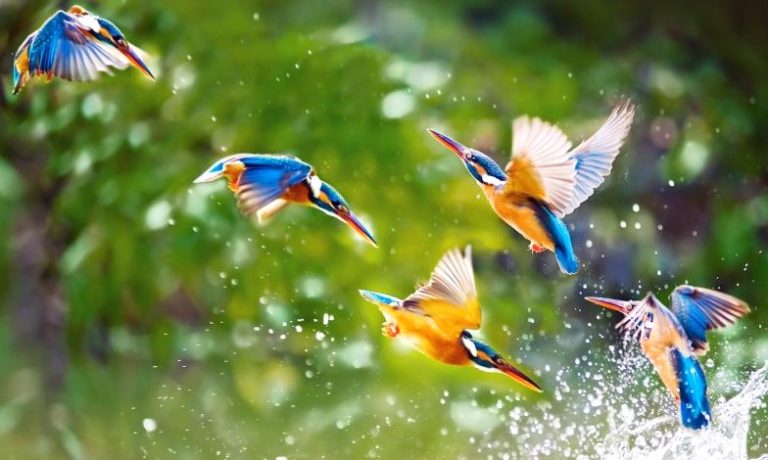As the summer season arrives in Nepal, the country’s forests and national parks come alive with the calls of migratory birds. Among the first to arrive are the Chestnut-headed bee-eaters and Indian paradise-flycatchers, both of which have been spotted nesting in different parts of the country. These birds travel thousands of miles, primarily to breed and raise their young. According to experts, Nepal’s favorable climate and rich biodiversity make it an ideal location for these birds to nest and raise their fledglings.
Migratory Birds Arriving in Nepal for Breeding
The Bhairahawa-Taulihawa road stretch in Rupandehi district, along the Danav River, is currently buzzing with activity as migratory birds settle into the area to nest. Among them are the Chestnut-headed bee-eaters, locally known as Katustauke muralichara, which are seen digging holes in elevated ground to create their nests. These birds, hailing from Southeast Asia, have made their way to Nepal in search of suitable breeding grounds.
Similarly, the Indian paradise-flycatchers, known as Swargachari in Nepali, have been spotted in the northeastern parts of Tilaurakot Collaborative Forest in Kapilvastu district. These striking birds are also in search of secure areas to build their nests.
The Journey of Migratory Birds to Nepal
Every summer, migratory birds travel long distances from their native habitats to Nepal. Senior ornithologist Hem Sagar Baral explains that the Chestnut-headed bee-eaters, for instance, first arrived in Chitwan through Dharan around mid-January, after traveling from Southeast Asia. These birds look for nesting sites that offer the best conditions for breeding. Similarly, the Indian paradise-flycatchers arrived from northeastern India around mid-February.
By now, a large number of summer migratory birds have arrived in Nepal, with many continuing to search for safe nesting grounds. According to ornithologist Hathan Chaudhary, these birds look for areas with abundant foliage, food, and a secure environment. Once they find a suitable location, they begin nesting immediately.
One such example is the blue-tailed bee-eater, which has traveled approximately 1,680 miles from Thailand to reach the community forests of Kawasoti in Nawalpur district.
Why Nepal is a Haven for Migratory Birds
Nepal’s climatic conditions, abundant food sources, and safe environment make it a perfect stopover for summer migratory birds. Ornithologists estimate that around 60 species of birds migrate to Nepal each summer to lay eggs, hatch them, and raise their young. By mid-February, nearly 57-58 species have already arrived in the country, though some, like the Asian koel, are still en route.
The Asian koel, which migrates over 6,000 miles from Sub-Saharan Africa, passes through Ethiopia, Somalia, and Yemen before crossing the Arabian Sea. According to ornithologist DB Chaudhary, the koel typically arrives in Nepal by late May, riding the pre-monsoon winds from the Arabian Sea.
Other birds such as the Indian golden oriole, the orange-headed thrush, and the black-naped monarch have already been spotted in Chitwan National Park and various forests in Lumbini.
Species on the Move: Assessing Nesting Sites
Migratory birds in Nepal, such as the western hooded pitta, Indian pitta, Indian cuckoo, and the oriental dollarbird, are currently scouting potential nesting sites. These birds evaluate the local environment to ensure it provides the necessary conditions for raising their young. They typically choose trees in forests, riverbanks, and even agricultural fields as their nesting locations.
Birds from countries like India, Sri Lanka, Thailand, Cambodia, Laos, Myanmar, Malaysia, and Indonesia travel to Nepal for a period of four to ten days. Once they arrive, they breed, lay eggs, and nurture their chicks before beginning their return journey. Some migratory birds, such as the white-throated needletail, come from as far as Australia, although most species arrive primarily for breeding purposes.
Nesting Behavior and Breeding Cycles
As spring sets in, birds from across Asia begin to arrive in Nepal, each with a specific nesting behavior. It generally takes about three weeks for these birds to build their nests. While winter migrants return to the north, summer migratory birds arrive from the south. Among Nepal’s 19 koel species, 13 practice brood parasitism, laying their eggs in the nests of other birds.
By mid-May, most of these birds will have completed their nests, and by late July, their chicks will be ready to fledge. Larger bird species tend to take longer to raise their young, while smaller birds have quicker breeding cycles. The long daylight hours in Nepal provide ample time for the birds to forage, making it an attractive breeding ground.
Important Breeding Sites in Nepal
Nepal’s national parks and protected areas are crucial habitats for these migratory birds. Parks such as Chitwan, Bardiya, Shuklaphanta, Parsa, Shivapuri, and Banke host thousands of nesting birds each summer. In addition, areas like Koshi Tappu, Manohara, and the Annapurna Conservation Area have become major breeding grounds, along with several community forests.
While most migratory birds nest in the Tarai, some also settle in the mid-hills and even in the high Himalayas. These birds will remain in Nepal until September or October before heading back to their original habitats.
Increasing Biodiversity in Nepal
With the recent sighting of the Purple-backed sunbird, or Baijani Dhade Bungechara, in Kankadbhitta of Jhapa on February 19 by bird enthusiast Devendra Kharel, the total number of bird species recorded in Nepal has now reached 898. As more migratory birds continue to arrive, Nepal’s biodiversity grows richer, offering a wealth of opportunities for birdwatchers and researchers alike.


